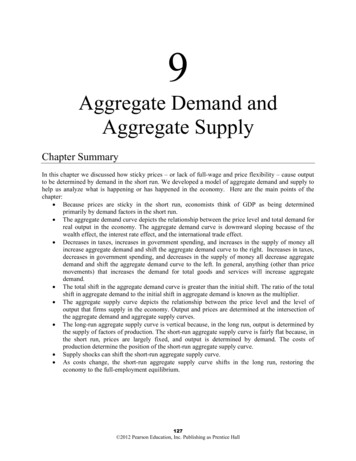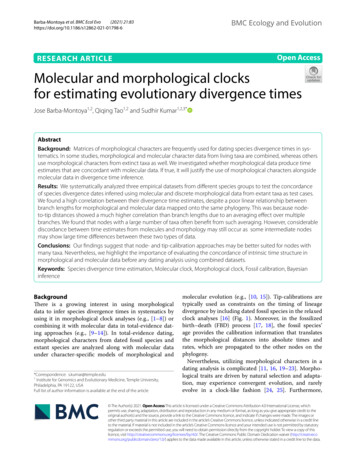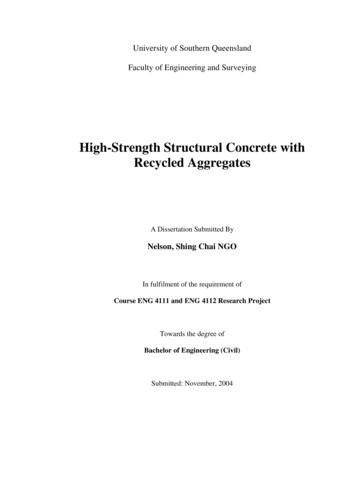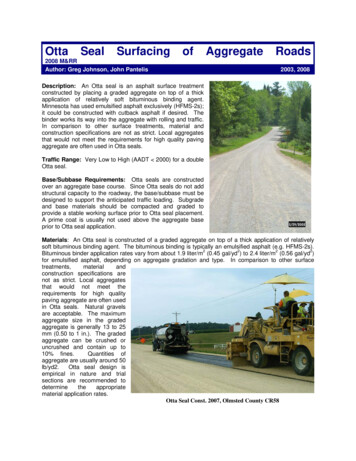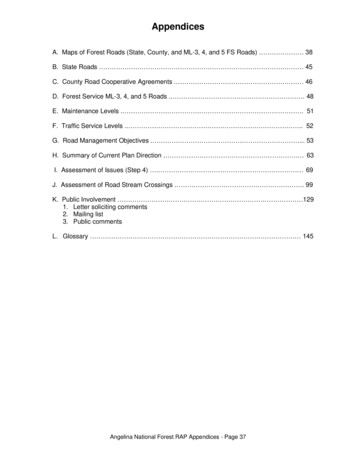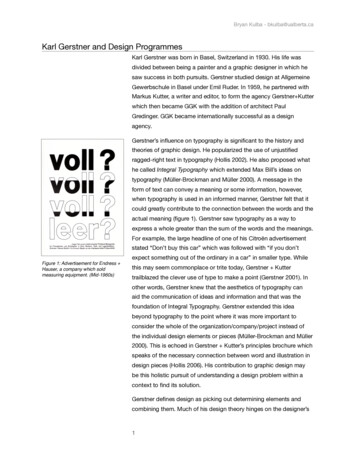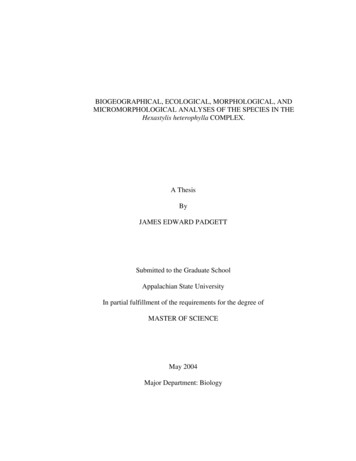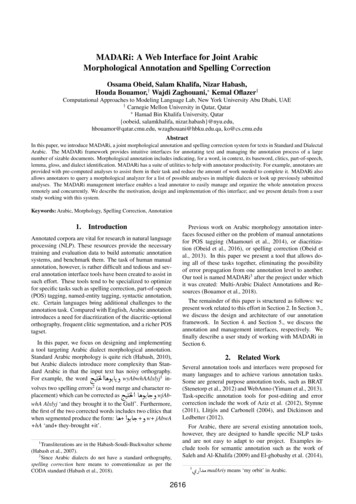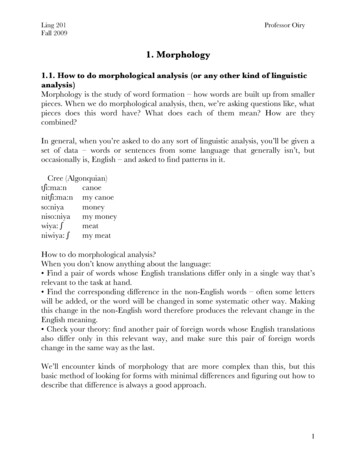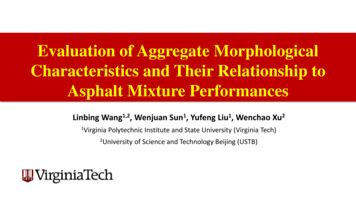
Transcription
Evaluation of Aggregate MorphologicalCharacteristics and Their Relationship toAsphalt Mixture PerformancesLinbing Wang1,2, Wenjuan Sun1, Yufeng Liu1, Wenchao Xu21VirginiaPolytechnic Institute and State University (Virginia Tech)2Universityof Science and Technology Beijing (USTB)
Content Introduction Fourier Transform Interferometry (FTI) system Aggregates and Morphological Characteristics Statistical Analysis Results Aggregate-Mixture Relationship Conclusions Acknowledgement
Introduction Aggregates are an important component in asphalt concrete, cement concrete,granular base and treated base. Morphological characteristics of aggregates significantly affect the workability,durability, fatigue response, and friction properties of PCC and HMA, etc.
Fourier Transform Interferometry (FTI)systemResolution improvesfrom 35.4 μm per pixelto 28.47 μm per pixel inboth x and y directions inthe improved FTI system.FiberSwitch675nmSLD808nm LDTo FringeSource
zFTI ImagesTop ViewSide ViewyTall zMapped Boundary3D Mapped Regionz(x1)yx1z(x2)x2Mapped BoundaryxShort zz3D Mapped Regionx
Morphology Characterization in the FTISystem ShapeSphericity Angularity and Texture3Ds DmDl2
Morphology Characterization in the FTISystem Angularity and Texture
Morphology Characterization in the FTISystem Angularity and Texture
Analyzed Aggregates
Analyzed Aggregates#8: 3/8’’(9.5 mm) – #4 (4.75 mm)#10: #4 (4.75 mm) – 0 mm#57: 1’’ (25.4 mm) – #4 (4.75 mm)#68: 1’’ (2.54 mm) – #16 (1.19 mm)#78: 3/4’’(19.5 mm) – #16 (1.19 mm)120 particles are images for each size fraction, and that is 960 particles in total.
Morphological Characteristics of Aggregates Sphericity Flatness Ratio
Morphological Characteristics of Aggregates Elongation Ratio Angularity
Morphological Characteristics of Aggregates Texture
Statistical Analysis Results Sphericity Flatness Ratio
Statistical Analysis Results: quantile-quantile (QQ)-normal plots Sphericity Flatness RatioAll the QQ-normal plots follow straight lines, indicating normaldistributions. (A sample of 120 particles is large enough.)
Statistical Analysis ResultsStaunton No. 68 has the greatest mean value of sphericity, indicating these particles are more equidimensional.Staunton No. 68 has the greatest mean values of both flatness ratio and elongation ratio, representing thatthere are a large portion of Staunton No. 68 particles that are flat and elongated.Staunton No. 68 has the greatest mean values of angularity, representing the most angular particlesCulpeper RAP particles have the roughest surface texture.
Statistical Analysis Results T-test (with 95% confidence interval)p-values for sphericity and texture are greater than 0.05, implying that Culpeper particles and Stauntonparticles have no obvious difference for these two morphological characteristics statistically.
Aggregate-Mixture Relationship Asphalt Concrete Mixtures
AggregateMixtureRelationship VolumetricProperties ofAsphalt ConcreteMixtures150-mm-diameter gyratory pillswere compacted to 65 gyrationsfor volumetric determination inaccordance with VDOTspecifications.VMA voids in mineral particleVFA voids filled with asphalt
Aggregate-Mixture Relationship – DynamicsModulus Dynamic Modulus of AsphaltConcrete Mixtures (AASHTO T 342)3,000,00013-1070: Bealton (Culpeper)13-1081:Staunton2,500,000Dynamic modulus, psio Industrial Process Controls, Inc. (IPC)universal testing machine (UTM 100)o Loading capacity: 25 to 100 kNo Five testing temperatures ranging from 14 Fto 130 F (from cold to hot)o Six testing frequencies ranging from 0.1 Hzto 25 Hz (from small to large)o The applied strain in the range of 75 to 100microstrainso Uniaxial mode without ,0000.000010.1Reduced frequency, Hz1000Culpeper mixture shows very close but slightly higher stiffness values at lowand intermediate temperatures compared to Staunton mixture. Staunton particles are more angular 12% RAP in Culpeper mixture Particle packing
Aggregate-Mixture Relationship – FlowNumber IPC universal testing machine (UTM 100) Temperature: 54 C Unconfined test mode with a deviator stressof 600 kPa A repeated haversine axial compressive loadpulse of 0.1 second every 1.0 second wasapplied to the three specimens. 10,000 cycles or permanent strain of 5% Permanent strain vs the number of loadingcycles relationship Flow number was determined numerically asthe cycle number at which the strain rate isat a minimum based on the Francken model.Asphalt content: 6.3%Asphalt content: 6.8%Staunton mixture has higher flow number than Culpeper Mixture.Flow number represent rutting resistance of AC. A high flow valueindicates AC mixtures tend has plastic behavior and tend topermanent deformation (i.e. more soft AC).
Aggregate-Mixture Relationship – BeamFatigue Four-point flexural beam fatigue tests (AASHTO T321 -2007)IPC fatigue beam test equipmentThree replicate specimens at threestrain levels (total of nine beams) foreach mixture type50.8 mm by 63.5 mm by 381 mmTemperature: 68 FStrain control mode: tensile strainsranging from 300 to 800 microstrainsSpecimen failure: the number of cyclesat which beam stiffness degraded to50% of the initial flexural stiffnessCulpeper StauntonAsphalt content: 6.3% 6.8%Staunton mixture has longer fatigue life may due to: greater angularity rough texture appropriate asphalt content
Conclusions Manual measurement results using a vernier caliper demonstrated that the improved FTIsystem is capable to accurately quantify particle morphological characteristics. Statistical analysis of FTI results for the eight particle fractions also indicated thecapability of FFT2 method to quantify morphological characteristics of particles. Laboratory experiment results show that mechanical performance of asphalt concretehas strong relation with aggregate morphological characteristics.o Culpeper mixtures and Staunton mixtures have very close values of dynamic modulus may due tothe fact that Culpeper particles and Staunton particle have similar angularity distributions.o Mixture from Staunton showed higher flow number compared to Culpeper Mixture. This mightbe resulted from higher asphalt content and the greater sphericity value of Staunton particlescompared to Culpeper particles.o The fatigue performance of SMA mixture from Staunton is superior to mixture from Culpeper,because Staunton particles show more angularity, meaning that Staunton particles retain morebonding areas with asphalt binder in the presence of water compared with Culpeper particles.
Future Research Establishment of qualitative relationship between morphologicalcharacteristics and mechanical performances of real pavementstructures.o Laboratory Experiments: Model Mobile Load Simulator (MMLS):compaction density, and dynamic modulus, aswell as rutting deptho Field Tests Pavement Distresses Sustainability Evaluation
Acknowledgements The study reported herein is funded by Virginia Center forTransportation Innovation and Research (VCTIR). Laboratory experiments of asphalt mixtures were conducted in VCTIRby D. Stephen Lane and Harikrishnan Nair.
Thank You Very Much!Questions/Comments?
Linbing Wang1,2, Wenjuan Sun 1, Yufeng Liu , Wenchao Xu2 1Virginia Polytechnic Institute and State University (Virginia Tech) 2University of Science and Technology Beijing (USTB) Content Introduction Fourier Transform Interferometry (FTI) system Aggregates and Morphological Characteristics
